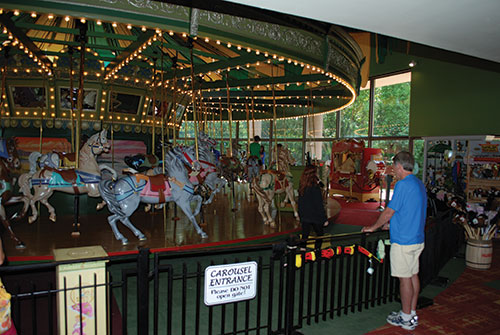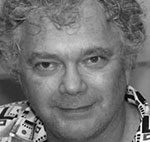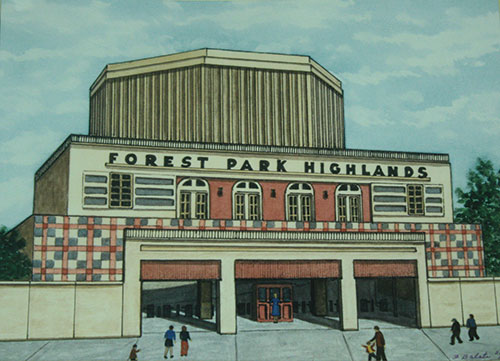
By Dwayne Hagens
The Scene staff
July 19 marked the 50th anniversary of the loss of a beloved St. Louis landmark.
A fire destroyed the Forest Park Highlands, also known as “The Highlands,” an amusement park that stood where St. Louis Community College at Forest Park is today.
Its memory is kept alive by The Highlands apartment complex down the street and the Hampton Inn, which displays photos and tickets from the park. But it’s a piece of local history that surprises many students.
“Amusement park?” asked mass communications major Kurtis Pittman, 26. “I really didn’t know about it.”
The park was built in 1896. It quickly became a staple in the community, bringing families together and entertaining children and adults for 67 years.
The entrance faced Forest Park, directly across from the area where the 1904 World’s Fair took place.
The first Highlands roller coaster, known as The Scenic Railway, operated in the same spot students now wait for city buses. Its track ran east along Oakland Avenue and turned south at Macklin.
Roller coasters seemed to be a main attraction at the park, considering there were so many. Favorites included the Bob Sled and Comet.
“I can recall my first ride on the Comet,” said Doug Garner, a St. Louis native who operates a website dedicated to the park (www.forestparkhighlands.com).

“It felt like my back was parallel to the ground,” he said. “Of course, it wasn’t. Then we made the turn into the first drop, and I was lifted out of my seat.”
Garner, 62, works as a hair stylist in Washington, D.C. He wrote a book called “Forest Park Highlands” in 2007 as part of Arcadia Publishing’s “Images of America” series.
The book and website give Garner’s perspective on what the park meant to South St. Louis residents and the surrounding community. He has been collecting memorabilia for decades.
“Just like people collect things that mean something to them, like a Michael Jackson lover might collect albums, or they may have a shiny glove that might be their prized possession, that’s how much I loved the park,” he said.
Garner’s most prized possession is a piece of the old carousel, which was removed during a renovation.
The carousel still is running inside a building at Faust Park in Chesterfield. Each year, thousands of people pay $2 to ride up and down on its horses ($5 for three rides).

“Everyone just loves the ride,” said Phyllis Goldberg, gift shop inventory manger for the company that owns and operates the carousel. “We throw a lot of birthday parties here.”
Another attraction at The Highlands was a theater for plays and concerts. Some of the most prominent singers, actors, actresses and comedians of the late 1800’s and early 1900’s graced its stage.
Later, the theater was remodeled and turned into a funhouse.
“Things jumped out at you and scared the living daylights out of you,” recalls Deanna Sims, 67, a retired teacher who frequented the park as a girl. “And there were mirrors that distorted your image.”
Sims remembers her first visit to The Highlands in the 1950s, when she was a first-grader at Shaw School. Students made hats and costumes and marched to the park, where they had an end-of-year school picnic with their families.
Sims vividly remembers sights and sounds of the park.
“In the evening, the rides had lights on them,” she said. “And the music coming of them was truly a wonder to behold for us.”
The Highlands also was home to the Smooth Dance Club. It wasn’t considered upscale, but men had to wear ties, which were sold at the door.
“As I got older and began dating, we would sometimes go there on dates,” Sims said.
After the 1904 World’s Fair, The Highlands inherited a famous structure: A pagoda patterned after a temple gate in Nekko, Japan, which had been used as an entrance to the midway.
When the fair ended, the pagoda was transported across the street and used as a band shell in the park. It was removed during World War II at the height of American-Japanese tensions.
The Highlands also had a shooting gallery with real guns, which would be unheard of in today’s world. It eventually was removed as a safety precaution, creating open space to keep fire from spreading.
But on July 19, 1963, the precaution didn’t work. A fire broke out around noon in the basement of a restaurant in the park.
More than 250 firefighters waged a battle in vain. The summer heat, the tarred roof of the picnic pavilion and shifting winds all played a part in the fire spreading.
Within hours, only a few structures were left standing.
“It was unbelievable,” Sims said. “I mean everyone was thinking, ‘How could this happen?’ The Highlands was our Six Flags back then. It was the only amusement park on the south side, so that’s where we went.”
The rides that managed to survive the fire were packed up and moved to other amusement parks.
The Flying Turns attraction traveled around before recently finding a home in Elysburg, Pa. It’s rumored that Little Toot, The Highlands train, was shipped to the Ozarks.
The park’s swimming pool, at one point the largest pool in the Midwest, was closed for good in 1965.
The Comet’s remains were the last to go. They were hauled off over three days in February, 1966.
Shortly after the fire, St. Louis Community College bought The Highlands property and began building its Forest Park campus, which has operated at 5600 Oakland Ave. since 1967.
The college kept the spirit of the amusement park alive by referring to Forest Park sports teams as “The Highlanders” for decades. But campus teams recently were consolidated under a single mascot, the Archers.
Sims’ biggest disappointment with losing the park 50 years ago was “no more school picnics.”
“(It was) a day of shock and disbelief when The Highlands closed permanently, signaling the end of an era,” she said.
